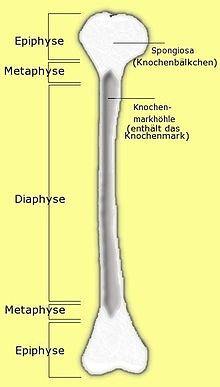- Metaphysis
-
The metaphysis is the wider portion of a long bone adjacent to the epiphyseal plate.[1] It is this part of the bone that grows during childhood; as it grows, it ossifies near the diaphysis and the epiphyses. At roughly 18 to 25 years of age, the metaphysis stops growing altogether and completely ossifies into solid bone.
Epiphyseal plates ("growth plates") are located in the metaphysis[citation needed] and are responsible for growth in the length of the bone.
Clinical significance
Because of their rich blood supply, metaphysis of long bones are prone to hematogenous spread of osteomyelitis in children.
Metaphyseal tumors or lesions include osteosarcoma, chondrosarcoma, fibrosarcoma, osteoblastoma, enchondroma, fibrous dysplasia, simple bone cyst, aneurysmal bone cyst, non-ossifying fibroma, and osteoid osteoma.[2]
References
- ^ Dorland's Pocket Medical Dictionary, 27th edition
- ^ "New Jersey Medical School, Pathology Department Introductory Course on Bone Tumours". http://www.umdnj.edu/tutorweb/introductory.htm. Retrieved 2009-03-12.
External links
- Organology at UC Davis Musculoskeletal/bone/structure0/structure2 - "Bone, structure (Gross, Low)"
Musculoskeletal system · connective tissue: bone and cartilage (TA A02.0, TH H3.01, GA 2.86–95) Cartilage perichondrium · fibrocartilage callus · metaphysis
cells (chondroblast · chondrocyte)
types (hyaline · elastic · fibrous)Bone CycleTypesRegionsStructureosteon / Haversian system · Haversian canals · Volkmann's canals · connective tissue (endosteum · periosteum) · Sharpey's fibres · enthesis · lacunae · canaliculi · trabeculae · medullary cavity · bone marrowShapesCategories:- Developmental biology stubs
- Skeletal system
Wikimedia Foundation. 2010.

